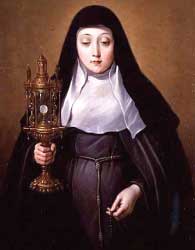 Clare was born in Assisi, Italy in 1193. As the daughter of wealthy parents, she was educated in reading and writing as well as in the domestic arts of spinning and needlework. Though raised among the nobility, she cared little for the social life that surrounded her. Greatly influenced by the piety of her mother, she decided to dedicate her life to God. Caring and praying for the poor, Clare saved food from her family table to distribute to the needy outside the doors of her home.
Clare was born in Assisi, Italy in 1193. As the daughter of wealthy parents, she was educated in reading and writing as well as in the domestic arts of spinning and needlework. Though raised among the nobility, she cared little for the social life that surrounded her. Greatly influenced by the piety of her mother, she decided to dedicate her life to God. Caring and praying for the poor, Clare saved food from her family table to distribute to the needy outside the doors of her home.
It is believed that Clare heard St. Francis preaching in the streets of Assisi. His new religious community of men called Friars, who relied solely on alms or begging for their needs, made a great impression on her. Clare’s parents decided that she would marry a wealthy young man. In desperation, Clare fled her home and sought refuge with Francis, who received her into religious life after cutting off her long hair.
Clare lived briefly at a nearby Benedictine monastery of nuns. Then she moved again for a short period to a house of female penitents, where she was joined by her sister Agnes. Clare and Agnes next moved to the Church of San Damiano, which Francis himself had rebuilt. Soon other women joined them, including her mother and other sisters, and they adopted a radically austere lifestyle. The small band of women became known as the “Poor Ladies”.
Unlike the Franciscan friars who moved freely around the country to preach, an itinerant life was hardly conceivable at that time for women. Instead, Clare’s sisters lived in enclosure and dedicated their lives to manual labor and prayer. Clare herself was greatly loved for her humility, faith and optimism. For a time, Francis himself directed the Order. Then in 1216, Clare accepted the role of abbess at San Damiano. As abbess, Clare defended her Order against attempts by prelates to impose on them a rule that closely resembled the Rule of St. Benedict rather than Francis’s stricter determination to rely on alms. Clare sought to imitate Francis’ virtues and way of life. She saw Francis as a spiritual father and played a significant role in encouraging and aiding him. She helped to care for him during the final illnesses of his life.
After Francis’ death, Clare continued to promote the growth of her Order. She wrote letters to abbesses in other parts of Europe. She thwarted attempts by each successive pope to impose any rule on her Order that would diminish their radical commitment to corporate poverty. She worked hard despite her own poor health. Toward the end of her life, when Clare was too ill to attend Mass, an image of the service would miraculously display on the wall of her cell. Eight centuries later, Pope Pius XII designated her as the patron saint of television.
On August 9, 1253, Pope Innocent IV accepted Clare’s rule as the governing rule for her Order. Two days later, on August 11, Clare died at the age of 59.
Clare was canonized by Pope Alexander IV on August 15, 1255. In further recognition of St. Clare, Pope Urban IV officially changed the name of the “Order of Poor Ladies” to the “Order of St. Clare” in 1263. Today, the “Poor Clares”, as they are often known, exist in over 70 countries.
